Our changing climate is already affecting the way we garden, so which plants should we grow now? We asked three leading garden designers, a respected planting designer and a dry gardening guru for their top picks of resilient plants for the future. Their choices are robust and adaptable, and range from low-maintenance groundcovers to trees, flowers and drought-tolerant evergreen sub-shrubs.
76 resilient plants chosen by experts
Picked by Conrad Batten

Designer Conrad Batten’s plant choices reflect the naturalistic spaces with sustainability at heart that are key to his design ethos, and offer an immersive and transportive experience.
Blechnum spicant

Known as the hard fern, this tufted evergreen fern helps brighten shady areas and combines well with many other shade-loving plants. AGM*. Height (H) 10-50cm. Spread (S) 10-50cm. Conditions (C) Poorly drained, humus-rich soil; full sun to part shade. Season of interest (SI) Year round. Hardiness rating (HR) RHS H6, USDA 5a-8b.
Briza media

Acts on the muting mauves and scumbling yellows of meadows. A short-lived, quivering, tufted clump of delight. H 30-75cm. S 10-30cm. C Well-drained soil; full sun. SI Year round. HR RHS H7, USDA 4a-8b.
Corylus avellana

A deciduous tree with yellow catkins in spring followed by hazel nuts in autumn. Leaves turn a rich yellow before they fall in October. H 4-8m. S 4-8m. C Moist but well-drained soil; part shade to full sun. SI Year round. HR RHS H6, USDA 4a-8b.
Crataegus monogyna

In the spring, the cream flowers of this deciduous tree buzz with life and are followed in autumn by rich berries. When leaves fall they reveal the purple of spiny twigs; each hawthorn has a story told through twisted stem and branch. H 4-8m. S 4-8m. C Moist but well-drained soil; part shade to full sun. SI Year round. HR RHS H7, USDA 4a-7b.
Daucus carota

The wild carrot’s white umbels, occasionally with a blush that swirls around a central purple pin, froth through high-summer plantings. Seeds sprout green in autumn’s nest-like seedheads. H 30-75cm. S 30cm. C Well-drained soil; full sun. SI Spring to autumn. HR RHS H7.
Digitalis canariensis

Burnt-orange, flame-flicked flowers with an apricot blush, rise from deep-green leaves on woody, stiff stems. The spires of bell-shaped flowers grow to varying heights creating candelabra-style colour. H 75cm-1.5m. S 75cm-1m. C Rich soil; sun and shelter, frost tender. SI Summer. HR RHS H2.
Geranium nodosum

In spring the young leaves of this knotted cranesbill unfurl like stretched hands. The pink petals, which have a metallic sheen, have a curious swaying habit. An excellent groundcover for the dappled shade of a tree. H 10-50cm. S 10-50cm. C Moist but well-drained soil; full sun to full shade. SI Spring to autumn. HR RHS H5.
Luzula sylvatica

An evergreen perennial sedge that forms clumps of ribbon leaves, edged with hairs. The open flowers rise above the foliage in May and June on stiff stalks. H 50cm-1m. S 50cm-1m. C Moist, rich, poorly drained soil; part to full shade. SI Year round. HR RHS H7. (Luzula sylvatica ‘Marginata’ pictured)
Myrtus communis

Brush this evergreen shrub and you’ll be treated to a delicious spiced aroma. Its pointed leaves, which shimmer after the rain, contrast with puffs of fluffed cream flowers in late summer followed by dark berries. AGM. H 1.5-3m. S 1.5-3m. C Moist but well-drained soil; full sun. SI Year round. HR RHS H4, USDA 8a-10b.
Persicaria amplexicaulis ‘Blackfield’

Blood-red flowers, carried on long, ranging stalks, work brilliantly as paint flicks of colour through grasses. Loved by pollinators, this clump-forming perennial has a long flowering period, and offers interest even when not in flower, especially in autumn when the trowel-shaped leaves take on chromatographic colour. H 50cm-1m. S 50cm-1m. C Poorly drained, moist soil; full sun. SI Spring to autumn. HR RHS H7, USDA 4a-7b.
Prunus cerasifera

In early spring, the cherry plum offers clouds of delicate, pink-tinged white blossom, while even the hawthorn still slumbers. Followed by edible plum-like fruits in autumn. Dark-grey speckled bark, develops fissures with age. H 8-12m. S 8m. C Adaptable but best in moist but well-drained soil; full sun or part shade. SI Spring and autumn. HR RHS H6, USDA 5a-8b.
Rosa ‘Noisette Carnée’

A climbing rose that is often still flowering at the end of November. Its small clusters of warm pink blooms are held on mid-green leaves. The clove scent is so delicious you simply want to close your eyes and drink it in. AGM. H 2-3m. S 3m. C Rich, moisture-retentive soil; part shade to full sun. SI Spring to autumn. HR RHS H4.
Rumex acetosa

The common sorrel throws up skyward wires of toasted-red flowers from mid to late summer. A low green presence, with apple-tasting leaves. Use it to stitch planting schemes together. H 50-75cm. S 10cm. C Well-drained soil; part shade to full sun. SI Summer. HR RHS H7, USDA 3a-7b.
Sarcococca confusa

Known as sweet box, this evergreen shrub is a winter enchanter, when all is quiet. A plant to linger by, and take in its sweet aroma on cold days when the temptation is to hurry on your way. The white tufted flowers hug the stem nestled in the leaf crook. H 1.5-2.5m. S 1-2m. C Moist but well-drained soil; full to part shade. SI Year round. HR RHS H5.
Thalictrum ‘Elin’

Leaves push from the ground in early spring, dark purple in their first flush before mellowing to a more glaucous green. The flowers rise and sway on tall stems, creating a haze of lavender-pink flower that demands to be stroked. AGM. H 1.5-2.5m. S 50cm-1m. C Moist but well-drained soil; part shade. SI July and August. HR RHS H7. Here's how to grow thalictrum
Picked by Marian Boswall

Marian Boswall is a landscape architect and her selection includes plants that will protect soil, lock up carbon, and provide food and shelter for wildlife but, most of all, are simply very beautiful.
Agastache ‘Blackadder’

A member of the hyssop family, this perennial has long been used in herbal medicine as an antiseptic. This dark, giant cultivar is the most hardy and has edible flowers that go on for months and are always covered in bees. Resistant to drought and also happy in clay it makes a great vertical accent. H 70cm. S 50cm. C Well-drained, moderately fertile soil; full sun. SI June to November. HR RHS H4, USDA 6a-9b.
Allium schubertii
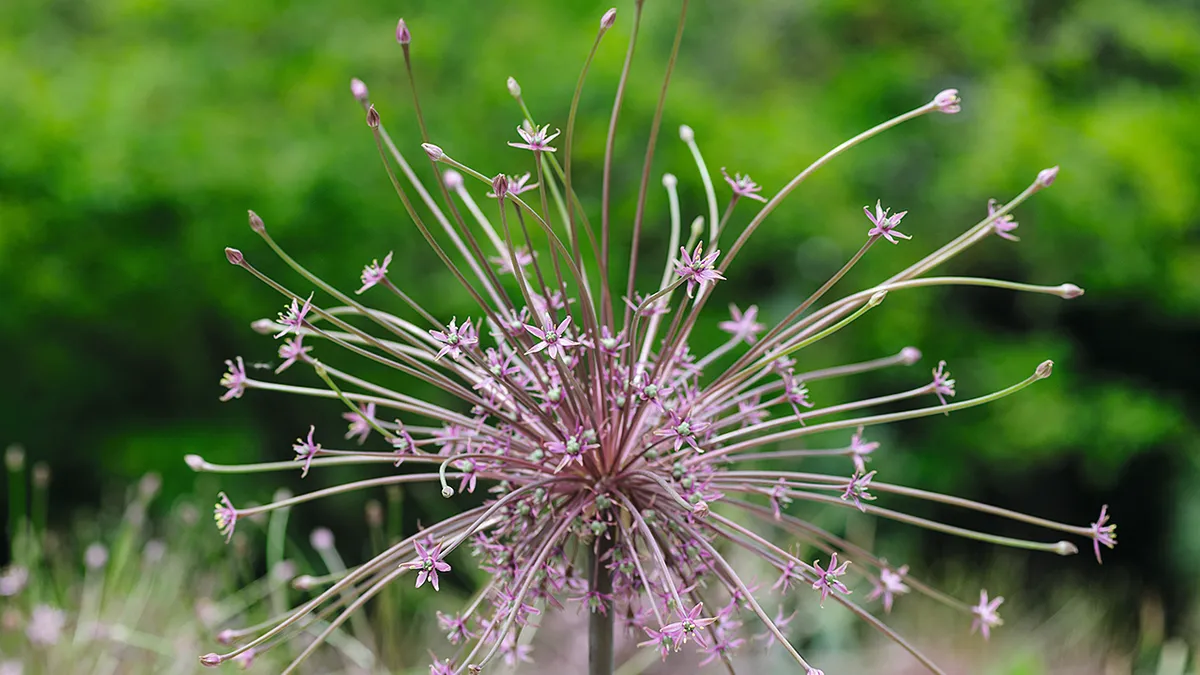
These enormous, lilac-coloured allium flowers look fabulously quirky in any border but are also great bee plants. The seedheads dry extremely well, creating super sustainable Christmas decorations. A perennial bulb. H 1m. S 1m. C Moist, well-drained soil; full sun or partial shade. SI April to May. HR RHS H4, USDA 5a-8b.
Arbutus unedo

Flowering in winter this small, evergreen tree or large shrub is a useful forage plant for brave bees out on a cold sunny day. Its edible strawberry-like fruits make it a great permaculture tree to add the mid layer of a forest garden. H 5m. S 5m. C Moist, well-drained soil; full sun. SI September to January. HR RHS H5, USDA 7a-10b.
Calamintha nepeta

A bridesmaid for the front of every sunny border. A perennial from the Mediterranean, it does well on chalk and sand, and is also happy on clay. Loved by bees and caterpillars, it is deliciously aromatic so less loved by rabbits. H 30cm. S 45cm. C Well-drained, moderately fertile soil; full sun to partial shade. SI May to November. HR RHS H5, USDA 5a-7b.
Camassia quamash

A brilliant perennial bulb to naturalise in a meadow setting. The dark-blue spires above narrow leaves are loved by bees and need very little attention, spreading gradually by seed if they are happy. H 60m. S 50cm-1m. C Moist but well-drained soil; full sun or partial shade. SI April to May. HR RHS H4, USDA 5a-9b.
Digitalis lutea
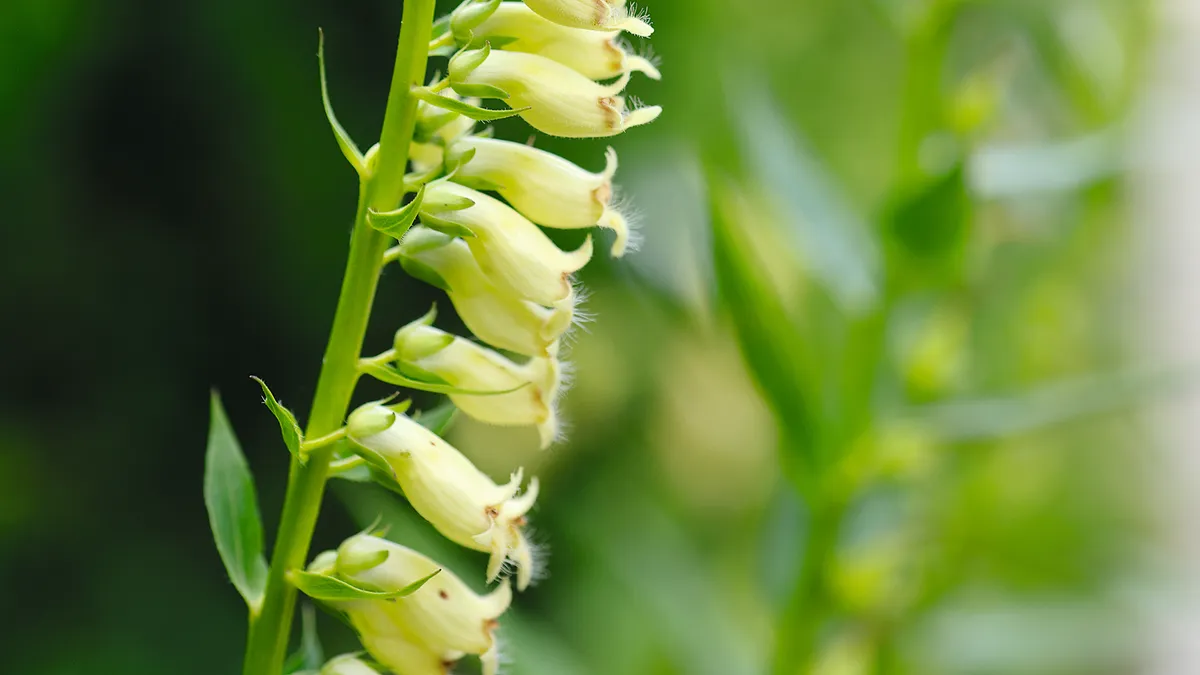
A tall and elegant beauty to brighten up a shady spot. Nodding trumpets provide a perfect landing spot for a bee. A short-lived perennial that looks great coming up through ferns and is less promiscuous than the common foxglove D. purpurea. AGM. H 90cm. S 30cm. C Well-drained, moderately fertile soil; full sun to part shade. SI May to July. HR RHS H6.
Iris ‘Benton Nigel’

A pop of deep-blue colour that appears just when we need it, this elegant Cedric Morris iris is from the justly famous Benton stable of irises. These are less showy than modern bearded irises, and once you’re smitten with their subtle colours, it is guaranteed you’ll find yourself wanting to collect all the colours. H 1m. S 40cm. C Light, well-drained soil; full sun. SI April to June. HR RHS H4.
Linum perenne

A blue to stop you in your tracks, this lovely little perennial flax speaks of summer skies and linen frocks. Great for a gravel garden or dry front of border, it’s hardy but looks so delicate with large heads on slender stems. H 50cm. S 40cm. C Light, well-drained soil; full sun. SI June to August. HR RHS H4, USDA 5a-8b.
Mahonia eurybracteata subsp. ganpinensis ‘Soft Caress’

The winter scent of a warm mahonia is such a waft of ‘welcome home’. This softer version of the shrub lacks the strident architecture of the usual mahonias and is easy to fit into any scheme. Good winter bee forage. AGM. H 60cm. S 12m. C Moist but well-drained soil; full sun to part shade. SI April to June. HR RHS H4, USDA 7a-10b.
Malus ‘Evereste’

The humble crab apple should have a home in nearly every garden. In late winter the birds mob the pretty fruits when all else is gone. In spring, a daily visit to inhale the scent and listen to the bees is food for the soul. AGM. H 4-8m. S 4-8m. C Moist, well-drained soil; full sun or part shade. SI April to May. HR RHS H6, USDA 4a-8b.
Nigella damascena

This hardy annual is so simple and yet so complex, with a centre like a passion flower and stunning seedheads too – a firm favourite for dry gardens especially. Great for bees, this is an annual that easily self-seeds, and the seeds are edible too. H 45cm. S 25cm. C Light, well-drained soil; full sun. SI June to November. HR RHS H3, USDA 2a-11.
Origanum ‘Kent Beauty’

Very sweet nectar makes this a bee and butterfly magnet, and the unusual pink flowers drip down among bracts like hops, making it a very Kentish plant. Great for pots and window boxes where the scent can drift in when brushed. AGM. H 30cm. S 20cm. C Light, well-drained soil; full sun. SI July to September. HR RHS H4, USDA 6a-9b.
Orlaya grandiflora

If you have only one annual, this has to be it. The most delicate of umbels that threads up through the border or in the gravel garden, pure white and brimming with forage for pollinators right to the first frosts. A hardy annual it self-seeds in light soil. AGM. H 60cm. S 60cm. C Light, well-drained soil; full sun. SI June to October. HR RHS H7.
Phacelia tanacetifolia

A plant that helps feed both the soil and the bees. Phacelia is a pretty, green manure that you cut down while in flower to allow the nutrients to stay below. It will hum with beneficial insects all summer, a fast groundcover and prolific self-seeder. H 1.2m. S 45cm. C Any fertile soil; full sun. SI June to September. HR RHS H4.
Prunella vulgaris

An easily overlooked, but key wildflower meadow plant. Self heal is also an essential healing herb and soil-knitting stalwart in the sward. Drink it in an infusion, or leave for the bees. H 20cm. S 20cm. C Moist but well-drained soil; full sun or partial shade. SI April to August. HR RHS H5.
Rudbeckia occidentalis ‘Green Wizard’

A tough prairie perennial that does well in most places including heavy soils in sun. The unusual cone heads are food for butterflies and bees and the seedheads stand through the winter attracting goldfinches and look striking against a low, winter sun. H 1.2m. S 60cm. C Any fertile soil; sun or part shade. SI August to October. HR RHS H7.
Sambucus nigra

Small tree or shrub. A beautiful addition to any sustainable garden. The pretty, spring flowers and deep purple autumn fruits are both delicious and used medicinally. Plus great forage for wildlife. H 4m. S 3m. C Moist, well-drained soil; full sun. SI Spring and autumn. HR RHS H6, USDA 5a-8b.
Selinum wallichianum

With masses of starry parsley heads above pretty, fern-like, cut leaves, this is a delightful froth of bee fodder for any border. Its red stems look wonderful with Sanguisorba ‘Tanna’ bobbing through. A medicinal plant in the permaculture garden. AGM. H 1m. S 1m. C Moist, well-drained soil; full sun. SI July to September. HR RHS H6, USDA 6b-10b.
Viburnum carlesii

With a perfume to turn heads in early summer, this is my favourite of this useful genus. Flowers are white to pink in pom-poms with red edges, and are loved by bees. The glossy green leaves turn red edged in autumn. A fabulous mid layer shrub. H 1.8m. S 2m. C Moist, well-drained soil; full sun to full shade. SI April to July. HR RHS H6 USDA 4a-7b.
Picked by Nigel Dunnett

Professor Nigel Dunnett is known for his exciting planting schemes. His choices are all robust plants with strong character that fit nicely into the layers of naturalistic plantings, and above all have multiple seasons of interest.
Agapanthus ‘White Heaven’

Really large heads of pure-white flowers in late summer over evergreen foliage. These are so exotic, but what I really like, in addition, are the papery seedheads and prominent pure black seeds, adding so much extra value. H 1m. S 50cm. C Moist but well-drained soil; sun with some shelter. SI Summer to autumn. HR RHS H4, USDA 7a-10b.
Ammi majus

Produces beautiful, billowing clouds of pure white from June through to September. A hardy annual that is easy from direct sowings outside in spring. Looks lovely scattered through perennials. AGM. H 1m. S 50cm. C Well-drained soil; sun or half-shade. SI Summer. HR RHS H6.
Anemone x hybrida ‘Honorine Jobert’

Pure-white flowers in virtually never-ending abundance – starting in July and going on into November at head height. This anemone is perfect for bringing light into shady places. Needs plenty of space of course. AGM. H 1m. S 50cm. C Moist but well-drained soil; sun or part shade. SI Year round. HR RHS H7, USDA 4a-8b.
Aster x frikartii ‘Mönch’
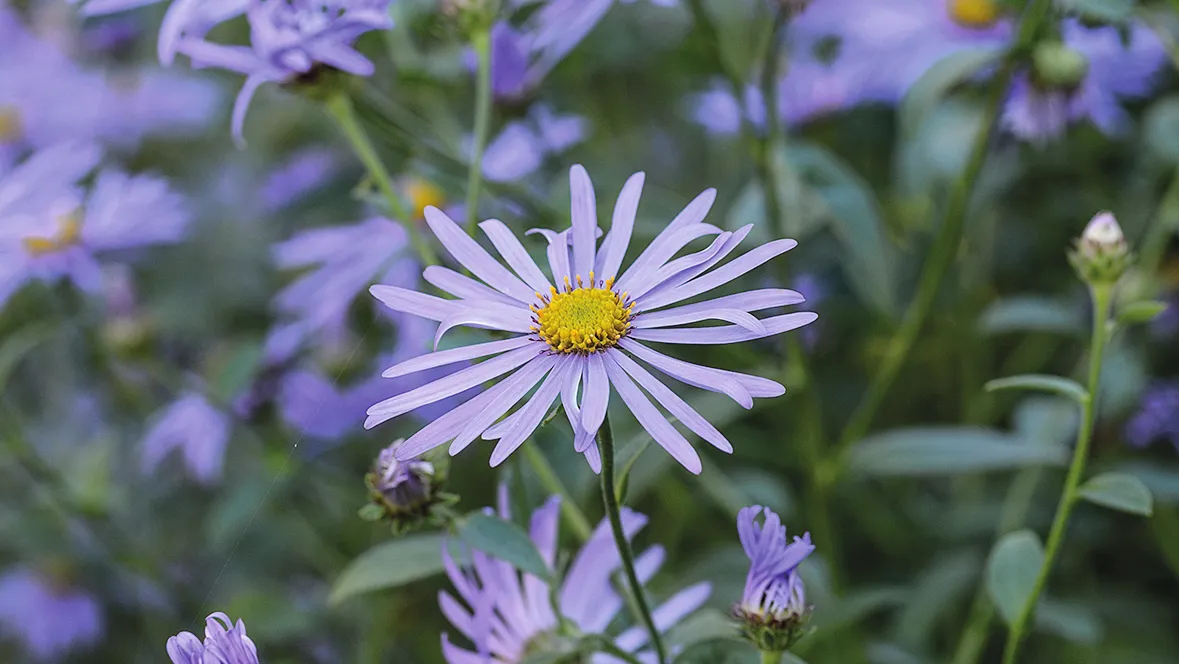
Is this the longest-flowering aster? Probably. It starts in August, and is often still going in November. The plants are open and quite floppy, but there’s no need to support them if you use them among plants they can weave through. AGM. H 60cm. S 50cm. C Moist but well-drained soil; full sun. SI Summer to autumn. HR RHS H7, USDA 6a-10b.
Astilbe chinensis var. taquetii ‘Purpurlanze’

What a true multi-season plant! Its leaves emerge cherry-red in spring and then develop into lovely ferny foliage. The flower spikes in bud are beautiful, the purple-pink flowers shine, and the seedheads stand all winter long. AGM. H 1m. S 50cm. C Moist soil; full sun. SI Year round. HR RHS H7, USDA 4a-8b.
Calamagrostis brachytricha ‘Mona’

A wonderful, medium-size grass that looks good virtually every day of the year. The shoots emerge olive green, with purple leaf and flower stems. The silvery-grey, fluffy flowerheads are pink-tinged and it bleaches out perfectly all winter. H 1m. S 1m. C Well-drained soil that is not too dry; sun or partial shade. SI Year round. HR RHS H6, USDA 4a-9b.
Dianthus carthusianorum
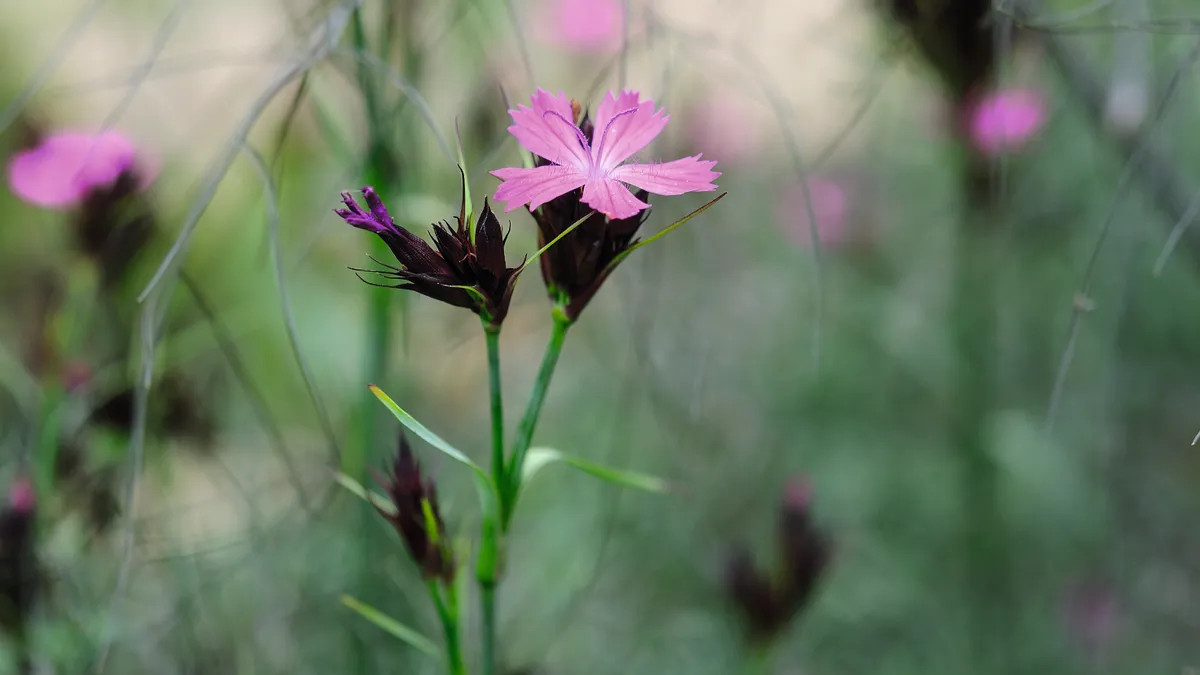
A real go-to plant for dry meadow and steppe plantings. Produces heads of small, vibrant, pink flowers on long stems, over several months. Will self-seed around if happy. A green-roof stalwart. H 40cm. S 30cm. C Dry, well-drained soil; full sun. SI Spring to summer. HR RHS H7.
Erigeron annuus

A real pop-up plant! Delicate, small, white daisy flowers from August to December – really beats any white-flowered aster hands down. Great for mingling with robust perennials. Simply thin out seedlings each year where they’re not wanted. H 1m. S 50cm. C Light, well-drained soil; full sun. SI Summer to winter. HR RHS H6, USDA 2a-7b.
Geranium Patricia (= ‘Brempat’)

Patricia has lime-green young leaves, and an amazingly long flowering time, from early summer through to November, and is almost a vine, sending out weaving branches that wind their way through other plants, popping out all over the place. Great naturalised into a meadow. AGM. H 50cm. S 2m. C Moist but well-drained soil; sun or half shade. SI Spring to autumn. HR RHS H7, USDA 4a-8b.
Hesperantha coccinea ‘Major’

There’s something very special about the sheer lusciousness of these tall spikes of crimson-red flowers in late summer and early autumn. Nice to mingle among Rudbeckia fulgida for a startling combination. AGM. H 70cm. S 30cm. C Moist but well-drained soil; sun. SI Autumn. HR RHS H4, USDA 7a-9b.
Heuchera villosa ‘Autumn Bride’

Lovely mounds of soft, downy foliage look good from spring through to autumn and then take on fantastic autumn colours. Tall spikes of cream flowers. Works well among open, multi-stem shrubs or trees. H 60cm. S 40cm. C Moist, not too dry soil; sun or half shade. SI Spring to autumn. HR RHS H6, USDA 3a-8b.
Hydrangea aspera Villosa Group

Greyish, felted, sensual leaves, purple and white flowers, beautiful flaking bark in the winter and an open structure, this is a magnificent shrub for structuring woodland-edge plantings. H 2m. S 2m. C Moist but well-drained soil; sun or part shade. SI Year round. HR RHS H5.
Miscanthus sinensis ‘Silberfeder’

A totally reliable Miscanthus that produces masses of flowers – which is what I grow Miscanthus for – in autumn. These stay on right through the winter. And it still looks great in January. Very upright plants, and the leaves have a silver mid-rib. AGM. H 1.5-2m. S 1m. C Moist but well-drained soil; sun. SI Year round. HR RHS H6, USDA 4a-9b.
Narcissus ‘Actaea’

The flowers of this gorgeous daffodil are oh-so elegant and beautifully scented too. The white flowers are combined with a small, yellow-orange cup that has a darker rim. Lovely in clumps and groups, but naturalised en masse in a meadow it’s breath-taking. AGM. H 30cm. S 30cm. C Moist but well-drained soil; sun to part shade. SI Spring. HR RHS H6, USDA 4a-8b.
Primula vulgaris

Indispensable herald of the gardening year. And not just for woodland shade: use it as an early flowering base layer among perennial plantings – it feels at home under the taller herbaceous canopy. AGM. H 20cm. S 20cm. C Moist but well-drained soil; full sun to part shade. SI Spring. HR RHS H7, USDA 4a-8b.
Pulmonaria ‘Diana Clare’
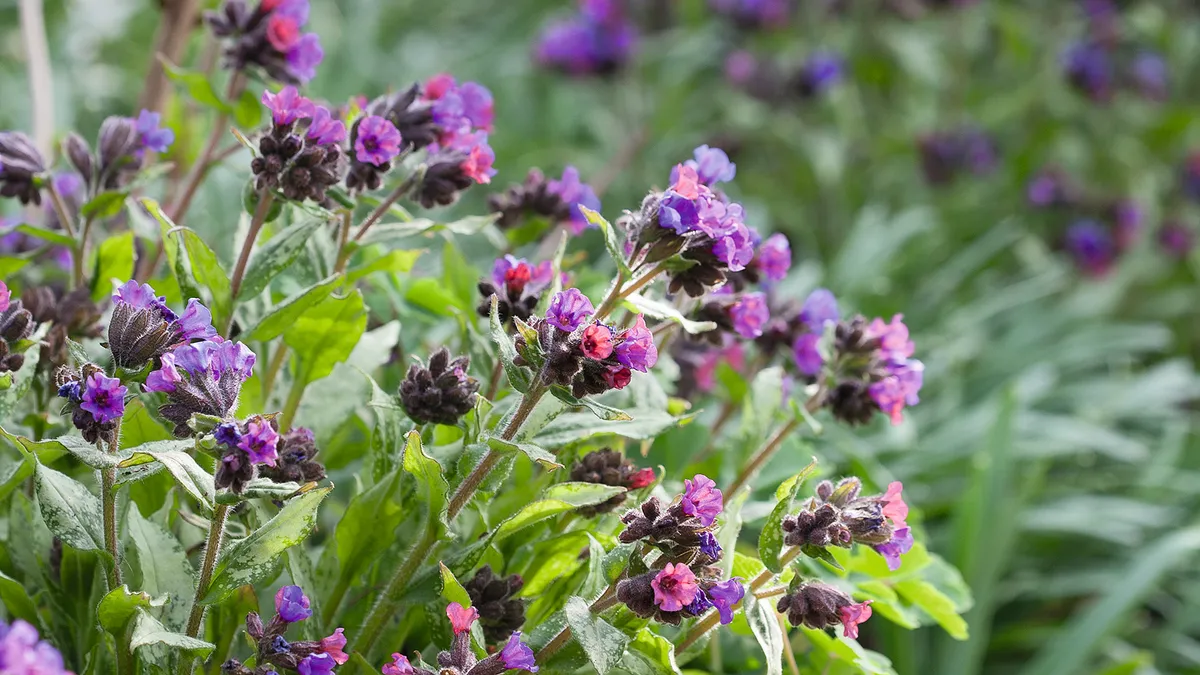
I generally don’t go for many variegated plants but this – and the very similar P. ‘Cotton Cool’ – is an exception. Its silvery leaves look good from spring to winter and has blue spring flowers. Much easier than hostas. AGM. H 30cm. S 30cm. C Moist but well-drained soil; full to part shade. SI Year round. HR RHS H6.
Rudbeckia fulgida var. deamii

One I can’t do without. Soft apple-green foliage – much better than all the other cultivars including the better known R. fulgida var. sullivantii ‘Goldsturm’ – and yellow flowers with black pincushion centres that last until late autumn. Plus perfect winter skeletons. AGM. H 60cm. S 40cm. C Moist but well-drained soil; full sun or half shade. SI Summer to winter. HR RHS H6, USDA 3a-9b.
Sanguisorba ‘Blackthorn’

Low mounds of fresh ferny foliage and tall, upright stems holding narrow, strong pink flowers. Self-supporting and see through. Sanguisorba is great in a meadowy planting with tall equally see-through Molinia cultivars. H 1.2m. S 40cm. C Moist but well-drained soil; full sun to part shade. SI Year round. HR RHS H7, USDA 4a-8b.
Thymus ‘Jekka’

A really vigorous, totally bright, fresh, evergreen thyme that doesn’t become gappy or straggly. Ideal for groundcover in dry places, or trailing over walls. Covered in mauve flowers on long stalks in early summer. H 20cm. S 60cm. C Well-drained, neutral to alkaline soil; sun. SI Year round. HR RHS H6, USDA 5a-9b.
Picked by Olivier Filippi

A pioneer of drought-tolerant planting, Olivier Filippi runs a specialist nursery in the South of France. He has selected plants from his Mediterranean garden that are as ornamental as they are functional, and are already grown in UK.
Achillea coarctata

An elegant groundcover from Turkey and the Balkan region with finely cut, silver-grey leaves growing in downy rosettes and contrasting with the bright-yellow flowers. Its strong rhizomes can check erosion on slopes. H 30cm. S 60cm. C Dry, poor soil; full sun. SI Year round. HR RHS H5.
Centaurea bella

One of the best evergreen groundcovers for dry gardens and attractive to butterflies. Needs little weeding as the plant releases germination inhibiting compounds (allelopathy). H 20cm. S 40cm. C Tolerates a wide range of soils; full sun or partial shade. SI Year round. HR RHS H5.
Cistus x porphyreus ‘Purple Patch’

An attractive new selection bred by Yorkshire Cistus specialist Bob Page. Aromatic, evergreen foliage and large, purple flowers with dark blotches. H 1m. S 1m. C Best in poor, stony or sandy, dry soils; full sun. SI May to June. HR RHS H4.
Euphorbia rigida

The striking silver-blue leaves that spiral around the stems take on a pink tinge in winter. Flowerheads stay attractive over a long period; bright-yellow in winter, orange in spring and fading to crimson in early summer. Self-seeds easily. AGM. H 30cm. S 50cm. C Well-drained soil; full sun. SI Year round. HR RHS H6, USDA 7a-10b.
Lomelosia minoana
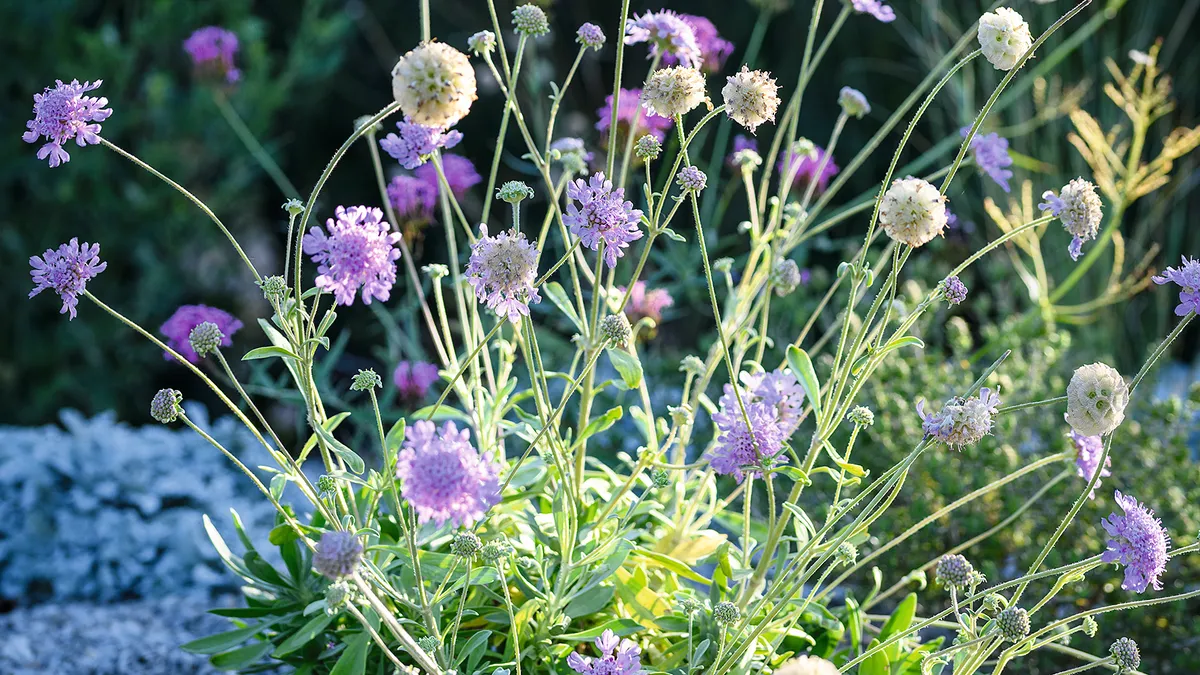
This sub-shrub from southern Crete is probably one of the most attractive plants for dry gardens. Soft, velvety, grey-green foliage and dense mounding habit. The lilac flowers in spring are followed by fluffy seedheads that stay attractive all summer. H 80cm. S 1.2m. C Well-drained, dry soil; full sun or partial shade. SI Year round. HR RHS H4.
Salvia multicaulis

The small, violet flowers of this aromatic perennial. grow out of large crimson calyces. Extremely attractive as a rockery plant or small groundcover for gravel gardens. AGM. H 25cm. S 30cm. C Best in poor, stony or sandy, dry soils; full sun. SI Spring. HR RHS H3.
Picked by Tom Massey

Tom Massey is a garden designer who has won several Gold medals at Chelsea Flower Show. His plant choices are all adaptable species, suitable for a range of locations and for the UK’s increasingly extreme weather conditions and challenging garden spaces.
Acanthus mollis ‘Rue Ledan’

Dramatic, tall and elegant flower spikes, loved by bees who crawl right inside the trumpet-shaped flowers. Large, dark-green, serrated leaves at the base that will hold though winter in milder areas. Perfect for lighting up shaded areas. AGM. H 1.5m. S 1m. C Moist but well-drained soil; sun to part shade or shade. SI Summer. HR RHS H6, USDA 7a-10b.
Asplenium scolopendrium

Seen growing all over the British Isles, this little evergreen fern is great for filling gaps almost anywhere; it will grow in damp rockeries, dry-stone walls or crevices between boulders. AGM. H 45cm. S 45cm. C Moist but well-drained soil; part or full shade. SI Year round. HR RHS H6, USDA 5a-9b.
Cerinthe major ‘Purpurascens’

Honeywort produces a sweet, honey-flavoured nectar irresistible to bees. It has very unusual bell-shaped, purple flowers, hooded by deep blue-green glaucous leaves. Blooming from spring to autumn, they produce large black seeds that are explosively released, don’t cut back too early and allow it to go to seed if you want it to persist in your garden. H 45cm. S 30cm. C Well-drained soil; sun. SI Spring to summer. HR RHS H3.
Deschampsia cespitosa ‘Goldtau’

There are many good D. cespitosa cultivars to choose from, but this golden dew (tau is German for dew), is one of my favourites. Smaller and more compact than some, it produces a gold haze of gauzy flowers emerging from a buff-green base of slender leaves. Looks amazing planted en masse as a single species, or mixed with airy flowering perennials such as Sanguisorba ‘Tanna’. AGM. H 60cm. S 60cm. C Moist but well-drained soil; sun or part shade. SI Summer to autumn. HR RHS H6, USDA 4a-9b.
Digitalis ferruginea

My favourite foxglove – a real gem that will light up shady spots. Can be biennial or a short-lived perennial. Sends up tall flower spikes with close-set buds that open to short trumpets of orange-yellow flowers with brown veining. Looks great naturalised through ornamental grasses. AGM. H 1.2m. S 30cm. C Moist but well-drained soil; shade, part shade or sun. SI Summer HR RHS H6, USDA 4a-8b.
Disporum longistylum ‘Night Heron’

This rare perennial is fantastic for partially shaded or woodland planting areas. Bamboo-like stems of deep purple age to dark green. Narrow, bell-shaped green-cream flowers are followed by purple-black berries. Almost evergreen in mild climates or a sheltered spot but deciduous where temperatures drop lower. Cut back old growth before new purple shoots appear in spring. AGM H 1.5m. S 1m. C Moist, humus-rich, well-drained soil; part shade. SI Spring to autumn. HR RHS H6, USDA 5a-10b.
Eryngium yuccifolium

Fantastic for adding drama and an otherworldly feel to a planting scheme. Can be used as a filler to dot through a border, or as a statement in a pot. Protect from winter wet. H 1.2m. S 1m. C Poor to moderately fertile dry soil; full sun. SI Summer to autumn. HR RHS H4, USDA 3a-8b.
Euonymus europaeus

Our native spindle comes into its own in autumn when leaves turn bright red and it produces berries that resemble little pink and orange lanterns. Looks stunning growing alongside ornamental grasses. H 3m. S 3m. C Moist but well-drained soil; sun or part shade. SI Autumn to winter. HR RHS H6, USDA 4a-7b.
Euphorbia myrsinites

One of my favourites among the many Euphorbia species, the broad-leaved, glaucous spurge produces whorls of fleshy leaves on trailing, prostrate stems. Acid-yellow flowers are produced in spring, but this plant has year-round interest. AGM. H 15cm. S 30cm. C Well-drained soil; sun. SI Year round. HR RHS H5, USDA 5a-9b.
Hakonechloa macra

Arching, elegant, green foliage that sways gently in the breeze. Fades through red to buff in the autumn; it will hold its foliage all the way through winter and can be cut back in early spring before new growth emerges. AGM. H 40cm. S 50cm. C Moist but well-drained soil; sun or part to full shade. SI Summer to autumn. HR RHS H7, USDA 5a-9b.
Helleborus argutifolius

Luminous-green flower spikes held above dark-green, holly-shaped foliage make this a standout plant. Try dotting through a carpet of Euphorbia amygdaloides var. robbiae. AGM. H 1m. S 40cm. C Moist but well-drained soil; part to full shade. SI Winter to spring. HR RHS H5, USDA 6a-8b.
Luzula nivea

A fantastic sedge ideal for damp shade. Will tolerate very wet and boggy conditions. Dense clusters of arching, white flowers emerge in spring that look beautiful grown en masse. H 60cm. S 60cm. C Moist but well-drained soil; full to part shade. SI Spring. HR RHS H5.
Miscanthus sinensis ‘Yakushima Dwarf’

Plumes of feathery flowers emerge in summer and persist into the autumn, when this ornamental grass really shines; the foliage turns a beautiful mix of red, bronze and gold. Cut back in early spring before new growth emerges. H 80cm. S 60cm. C Moist but well-drained soil; sun. SI Summer to autumn. HR RHS H6, USDA 5a-9b.
Molinia caerulea ‘Heidebraut’

Fine plumes of dark flowers are held on long vertical stems borne above a basal mound of strap-like leaves. In autumn it turns bright orange-yellow, and has a transparent, ethereal quality. Best where it is backlit by the sun. H 1.2m. S 60cm. C Moist but well-drained soil; sun or part shade. SI Summer to autumn. HR RHS H7, USDA 4a-9b.
Punica granatum var. nana

Bright-red flowers emerge in the summer followed by miniature red pomegranate fruits. Leaves turn bright-yellow in autumn before dropping and leaving the fruit to shine. AGM. H 1.2m. S 1.2m. C Well-drained soil; sun. SI Summer to winter. HR RHS H3, USDA 7a-11.
Trifolium ochroleucon

The sulphur clover looks like a giant form of common clover with sulphur-yellow flowers loved by bees and butterflies. Native, but now quite rare, so grow this at home and help preserve the species. H 50cm. S 50cm. C Moist but well-drained soil; sun or part shade. SI Summer. HR RHS H7.
Veronicastrum ‘Fascination’
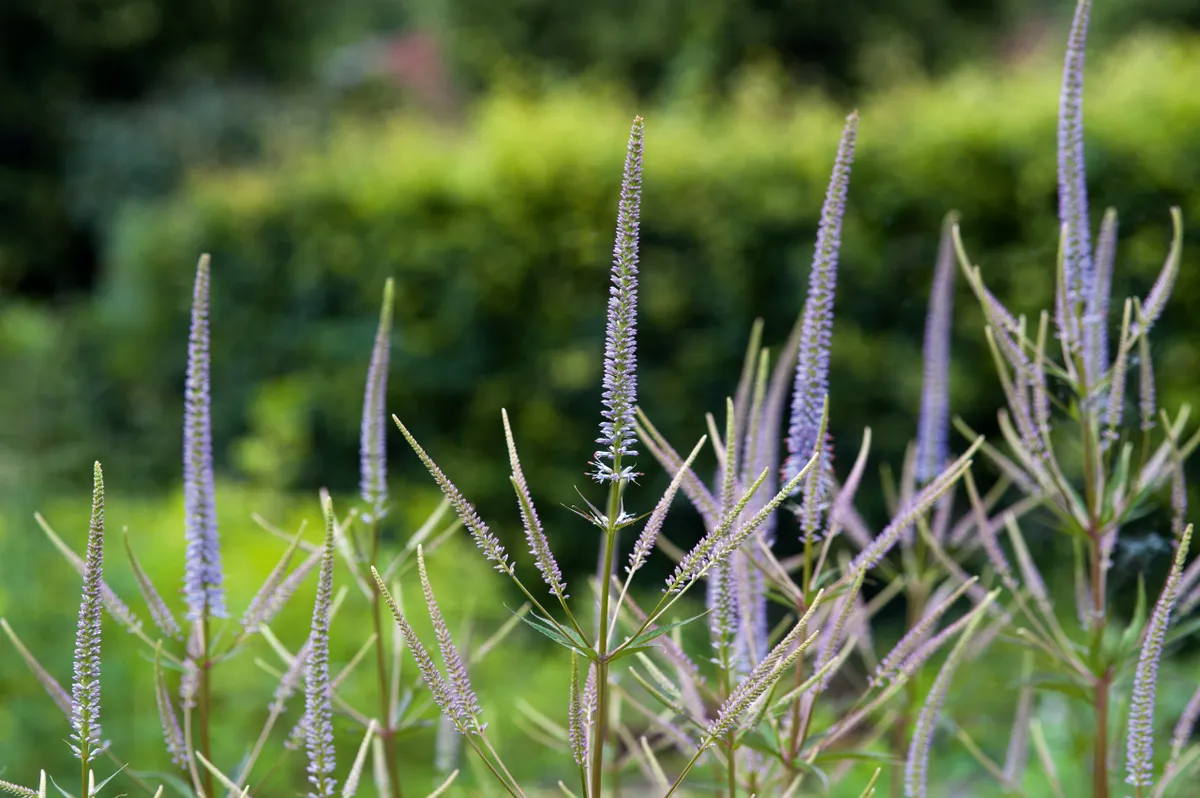
Invaluable for adding interest to the middle or back of a border, this tall perennial bares long, thin, leafy stems topped with candelabra-like racemes of lilac-blue flowers that bumble bees love. Veronicastrum seedheads offer interest well into winter. H 1.8m. S 50cm. C Moist but well-drained soil; sun or part shade. SI Summer to autumn. HR RHS H7, USDA 3a-8b.
*AGM: Holds an Award of Garden Merit from the Royal Horticultural Society




